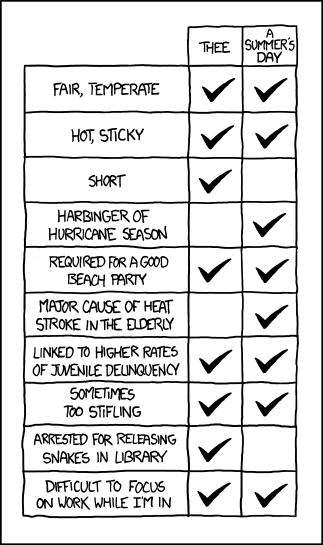- sonnets usually compare two or more contrasting ideas, emotions, beliefs, actions, events, images, etc.
- usually in iambic pentameter
- there are three main types of sonnets:
- Petrarchan/Italian
- first 8 lines are called an octave, and have a rhyming scheme A B B A A B B A
- next 6 lines are called a sestet and can have either 2 or 3 rhyming sounds, with much more freedom in how they can be arranged (like CDCDCD, CDECDE, CDDCEC, basically whatever! Even unpaired lines are okay [sometimes])
- however, they usually don't end in a couplet (as in, last two lines can't rhyme)
- often, the transition from the octave to the sestet signals a change of subject (called a "volta," or "turn")
- Spenserian
- invented by Edmund Spenseras
- pattern A B A B B C B C C D C D E E
- 14 lines: 3 quatrains and a couplet
- like the Petrarchan sonnet, the different divisions usually talk about distinct ideas
- volta often goes at the beginning of the final couplet
- Shakespearian/English
- pattern A B A B C D C D E F E F G G
- 14 lines: 3 quatrains and a couplet (like Spenserian, but without the overlapping rhymes)
- most flexible of all the sonnet structures because each line only has one rhyme, and there aren't strict rules about the placement of the volta (Shakespeare usually puts it after the first two quatrains, like the Petrarchan structure, or at the beginning of the final couplet, like the Spenserian structure)
- source: Sonnets.org
Furthermore, as promised:
UPDATE: check out my Allegory of the Cave sonnet. Can you guess which rhyme scheme I used?

Your blog is one of my favorites ! It's so insightful and helps give me the motivation I need to work harder. I hope to one day be on your level of hard work and skill. You're living proof that hard work pays off.
ReplyDeleteWhat's your strategy for writing essays and how do you intend on studying for the final?
Thank you so much, Jasmine! That really means a lot :)
DeleteWhenever I write an essay on the computer, I have a special process that I do with the prompt that helps me focus and get ideas. First, I copy and paste the prompt into my document, and then I break it up into short lines so it kind of looks like a poem. Then I change the colors of the individual words in grayscale-- for example, little words like "and" and "the" I make light gray, and big words like "evaluate" and "performative utterance" and "Hamlet" I make dark gray, and everything else somewhere in between. Breaking up the lines helps me identify each separate part of the prompt, and the different colors help me identify the most important parts of the prompt that I really need to focus on. As for in-class essays, I usually just circle the most important words. It isn't as extensive, but it's the same idea.
For the final, I'm probably going to reread my beloved Adventure Time stories to review for vocab, and scan all my other assignments for anything that seems like I've forgotten or maybe didn't understand fully in the first place. If there is anything that I especially need to review, I'll read 2 or 3 other classmates' blogs so I'll be sure and know everything for the final.
Thank you very much for your time !
DeleteI'm very grateful for the information provided. I hope to soon invent my own essay writing strategy that will assist me with both in and out of class essays.
Happy Thanksgiving ❤
I found these notes very helpful and also love how your blog is organized! Good job! I was wondering what your plans are for your final project? tduguranrhsenglitcomp13.blogspot.com
ReplyDelete